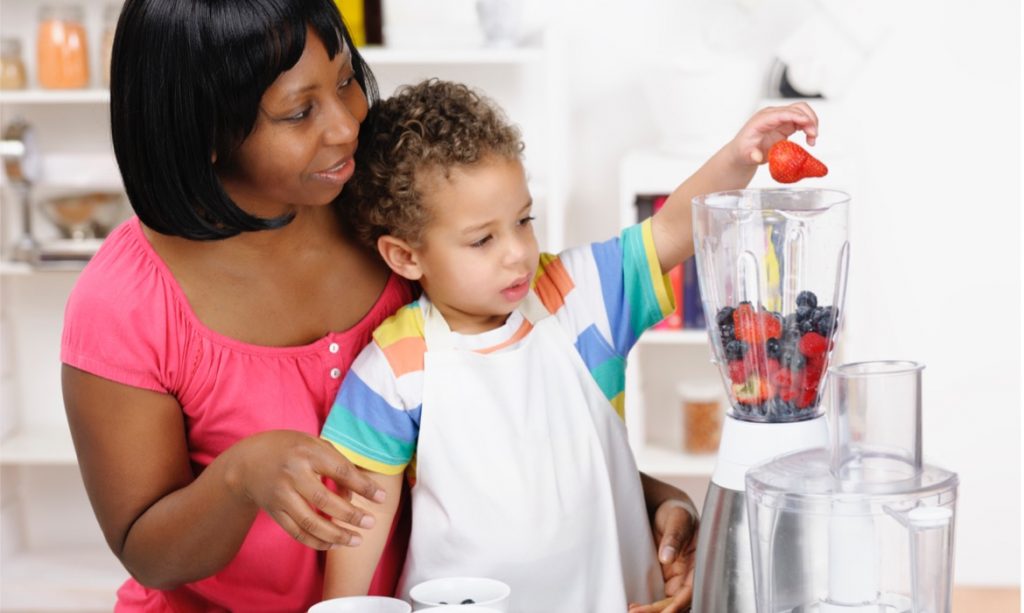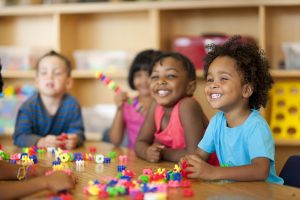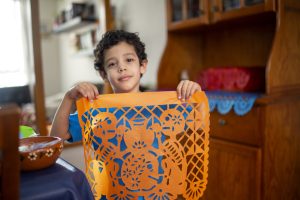- Cooking together as a family can help young children learn early math skills.
- Talking about numbers while cooking doesn’t take a lot of extra time for busy families.
- We offer easy recipes that children can help make and suggestions for talking about math while families cook together.
Cooking together can be a fun (and delicious!) activity for families with young children. It can also be an opportunity to explore important early math concepts. Whether counting the number of strawberries for a fruit smoothie or guessing the number of pancakes on a plate, time spent cooking together can go a long way to promoting children’s math learning.
How Can Family Cooking Time Support Early Math Learning?
Our research team spent the last year exploring how family cooking time can be used to support early math learning. We wanted to understand whether and how often families talk about math as part of their everyday cooking routine, what math topics they discuss, and whether there are ways to encourage even more conversations around math.
We recruited more than 50 preschool families from different ethnic, racial, and socioeconomic backgrounds and gave them cookbooks full of easy, kid-friendly recipes. Check out some of the most popular recipes on the DREME Family Math website.
Along with the cookbooks, half of the families also received tips for talking about math while cooking with young children. The tips focused on numbers and counting, because research has shown that understanding these concepts can predict later academic success. [1] [2]
Families followed the recipes and tips at home, and we asked that they record the time spent cooking together. The recordings shed light on the ways in which families talk about numbers in the kitchen, and how suggestions for talking about early math could help shape the conversation.
Families Enjoy Cooking Together
One of the most important findings from the recordings—and from families’ own feedback—is that families enjoyed making the recipes together!
Another important finding is that all of the families, regardless of whether they received the tip sheet, spent some time talking with their children about early math. However, families who received the cookbooks with tip sheets talked about the key counting concepts in our tips more than twice as much as families who did not receive the tips.
Moreover, the conversations among families who received the tip sheet focused on the kinds of concepts that support math learning beyond early childhood. For example, when children are learning to count how many pieces of food there are all together, they need to learn that the last number they count is in fact the total number of pieces. Families who received the tips helped their children to understand this concept more often than families who didn’t receive the tips.
When Parents Talk About Math, Kids Start Talking About Math
We found that the more parents talked about numbers and specific counting concepts—using the suggestions in the tip sheet as a guide—the more their children began to talk about math on their own, without prompting from parents. For example, after parents asked questions about counting, their children often counted the ingredients again later in the interaction, without being asked to do so.
Talking About Math Doesn’t Add Extra Cooking Time
Because all families are busy, we wanted to understand whether talking about numbers would add significant cooking time. We found that families who received the tips for talking about math spent the same amount of time making the recipes as those who did not receive the tips.
Cooking and Learning Together: Let’s Make a Fruit Smoothie!
One of the most-enjoyed recipes from the cookbook was the berry smoothie. In this recipe, we use strawberries and blueberries, but families can use their favorite fruits or whatever fruit is on hand. Simply cut the fruit into bite-sized pieces for children to practice counting. Here are some suggestions for talking about math while following the berry smoothie recipe:
- Put a few strawberries in front of the child and ask them to count the pieces one by one before putting them in a measuring cup.
- After the child counts the strawberries, ask, “How many are there in all?”
- Try also counting some blueberries or another favorite fruit one by one and ask how many there are all together.
- If the child easily counts the pieces, try a larger number. If the child struggles to count the pieces, stick with a smaller number until they grow more comfortable with counting.
- Practice simple addition by making a pile of two strawberries and a pile of three strawberries. Ask, “How many strawberries do we have in all?”
Tips for Talking About Math While Cooking with Young Children
There are easy ways that families can practice talking about math while cooking any meal together. Families can use our recipes or their own favorites—the tips for talking about math work across any meal or recipe.
Count ingredients one by one. Start with a small number (three or four) and ask children to count the number of pieces of food, using a finger to point to each piece. Children often don’t realize that each piece only gets counted once, or they try to count too quickly and skip numbers. Help them to keep track by moving the already counted pieces into a new pile.
Count the total number of ingredients. Ask children to count two, three, or four pieces of food and then say how many pieces there are all together. After they finish counting, ask, “How many do we have in all?” Or simply, “How many?” Move up to larger numbers as the child grows more comfortable with counting.
Guess which pile has more ingredients. Create two small piles of food and ask children which one has more in it. Then have them count the number of pieces in each pile to see if they are correct. Try asking them which pile has fewer pieces—something that many children find more challenging than estimating which pile has more.
Add or take away ingredients. After young children are able to correctly count the total number of pieces, they can be asked to do simple addition and subtraction. Add a piece of food to the pile and ask, “Now how many do we have?” Or take one piece away and ask, “How many do we have left?” Many children will need to count all of the pieces again in order to get the answer. As children grow more comfortable, families can try adding or taking away more than one piece of food at a time.
Easy Recipes That Kids Can Help Make
Talking about math while cooking together can increase the likelihood that children will talk and think about numbers on their own, without taking a lot of extra time for busy families. Here are recipes and tips to engage families around math learning while cooking together.
[1] Casey, B. M., Lombardi, C. M., Thomson, D., Nguyen, H. N., Paz, M., Theriault, C. A., & Dearing, E. (2018). Maternal support of children’s early numerical concept learning predicts preschool and first‐grade math achievement. Child development, 89(1), 156-173.
[2] Levine, S. C., Suriyakham, L. W., Rowe, M. L., Huttenlocher, J., & Gunderson, E. A. (2010). What counts in the development of young children’s number knowledge? Developmental Psychology, 46, 1309–1319. doi:10.1037/a0019671



